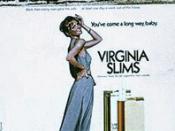At the beginning of the 20th century, female smokers were extremely rare. Smoking was synonymous with poor character, low social status, and prostitution. In fact, the stigma of women smoking was so great that that Congress considered banning women from smoking in the District of Columbia in 1921. (National Research Center for Women & Families, 2004) Tobacco companies have targeted women for years by appealing to the issues that women are interested in such as independence, stylishness, weight control, sophistication, and power. This had produced positive results for the tobacco companies, since rates of female smokers have soared since the 1960s. According to the National Center for Tobacco-Free Kids, "The consequences of these campaigns are staggering. Smoking among girls and young women increased dramatically in the 1990s. From 1991 to 1999, smoking among high school girls increased from 27 to 34.9 percent." (Partnership for Smoking or Health, 2001)
The introduction of female specific cigarettes in the late 1960s coincided with sharp increases in the number of girls aged 12-17 who began smoking, according to the Surgeon General.
(Partnership for Smoking or Health, 2001) "You've come a long way, baby!" touts the ad for Virginia Slims cigarettes, one of the most recognized brands for women. Since the women's rights movement was such an important issue at the time, appealing to a sense of freedom and independence was very alluring to women. The advertising tools used to target women have not changed much through the years. Philip Morris continued to market their cigarettes using images of "empowered" women throughout the 1970s and 1980s. The slogans on these ads usually focused on how women's lives had changed since the 1920s and 1930s, focusing on the new freedoms allowed to women. (Partnership for Smoking or Health) In the early 1990s, the image of...



Good job
I think that many women still smoke today despite the deleterious effects because they just are too stressedl. The women with less years of education are likely to be very unhappy with where their lives are going and smoke to take their minds off their problems.
2 out of 2 people found this comment useful.